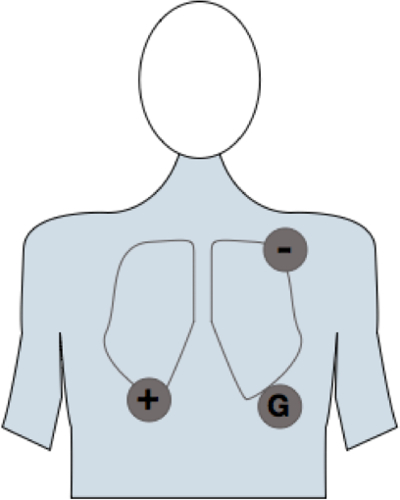生理相关的情感识别
Overview
资料来源: 乔纳斯 · 卡普兰和莎拉一、 贝尔实验室 — — 南加利福尼亚大学
自主神经系统 (ANS) 控制身体内部器官的活动,并调节其活动依赖于当前环境的变化。迷走神经支配的很多内部器官,是系统的重要组成部分。当我们的大脑感知危险时,抑制迷走神经张力,导致一系列旨在使我们能更好地战斗或逃跑; 身体的变化例如,我们的心率增加,我们的瞳孔放大,和我们的呼吸得更快。相反,当迷走神经系统被激活,这些生理反应是受到抑制,导致平静状态。迷走神经,然后,作为一种"刹车"对我们的觉醒。这平静的状态的一个有趣的结果是,它倾向于促进社会互动-当我们不紧张和害怕的我们周围的环境,我们就转而接受与别人交流。因此,此规管机制,运作不良可能是与社会行为的困难。
自主神经调节指标之一是心率变异性 (HRV)。心率变异性是衡量一个节拍和下一步之间的差距随着时间变化的多少。高 HRV 意味着随着时间推移,成功自主调节反射有心率持续波动。低 HRV 意味着随着时间推移,与贫穷的自主神经调节相关的条件还有一致性的心率。
在这项研究,我们将测试的假设,即增加心率变异性是与情绪刺激更准确分类相关联。1,2后研究公园et al.,我们将测量心率变异性和测试其协会措施于觉察面部表情技能的任务。3
Procedure
1.招募 40 名与会者。
- 与会者应该有正常或更正正常的视觉,以确保他们将能够看到正确的刺激。
- 参与者不应该食用酒精、 咖啡因或其他药物的实验至少 6 小时前。
- 与会者应该有神经、 精神科,或心脏疾病没有历史。
2.预试验程序

图 1: 电极放置。把心靠近身体右侧肋骨下的正极。心脏,左锁骨下方上方负面的地方。把心附近的左侧肋骨下的接地极。
- 将三个电极连接到胸部,记录心率 (图 1)。电极应预凝胶。请检查以确保这种凝胶不干。
- 在右侧修复下面肋骨笼正极。
- 解决跨心与正面电极形成对角线的左锁骨下方的负电极。 <
Results
Application and Summary
References
- Appelhans, B.M. & Luecken, L.J. Heart rate variability as an index of regulated emotional responding. Rev Gen Psychol 10, 229-240 (2006).
- Thayer, J.F. & Lane, R.D. A model of neurovisceral integration in emotion regulation and dysregulation. J Affect Disord 61, 201-216 (2000).
- Park, G., Van Bavel, J.J., Vasey, M.W., Egan, E.J. & Thayer, J.F. From the heart to the mind's eye: cardiac vagal tone is related to visual perception of fearful faces at high spatial frequency. Biol Psychol 90, 171-178 (2012).
- Chalmers, J.A., Quintana, D.S., Abbott, M.J. & Kemp, A.H. Anxiety Disorders are Associated with Reduced Heart Rate Variability: A Meta-Analysis. Front Psychiatry 5, 80 (2014).
- Kemp, A.H., et al. Impact of depression and antidepressant treatment on heart rate variability: a review and meta-analysis. Biol Psychiatry 67, 1067-1074 (2010).
- Gillie, B.L. & Thayer, J.F. Individual differences in resting heart rate variability and cognitive control in posttraumatic stress disorder. Front Psychol 5, 758 (2014).
跳至...
此集合中的视频:

Now Playing
生理相关的情感识别
Neuropsychology
16.4K Views

裂脑
Neuropsychology
68.5K Views

电机的地图
Neuropsychology
27.7K Views

神经心理学的观点
Neuropsychology
12.2K Views

决策和爱荷华州赌博任务
Neuropsychology
32.9K Views

Executive Function in Autism Spectrum Disorder
Neuropsychology
18.0K Views

顺行性遗忘症
Neuropsychology
30.5K Views

事件相关电位和古怪任务
Neuropsychology
27.6K Views

语言: 在语义错位 N400
Neuropsychology
19.7K Views

学习和记忆: 记得知道任务
Neuropsychology
17.3K Views

测量与基于体素的形态计量学的灰质分歧: 音乐的大脑
Neuropsychology
17.4K Views

解码听觉表象与磁模式分析
Neuropsychology
6.5K Views

功能磁共振成像视觉注意: 基于调查的对象的注意力控制
Neuropsychology
42.2K Views

弥散张量成像在创伤性脑损伤
Neuropsychology
16.9K Views

利用经颅磁刺激在行动观察测量运动兴奋性
Neuropsychology
10.3K Views
版权所属 © 2025 MyJoVE 公司版权所有,本公司不涉及任何医疗业务和医疗服务。